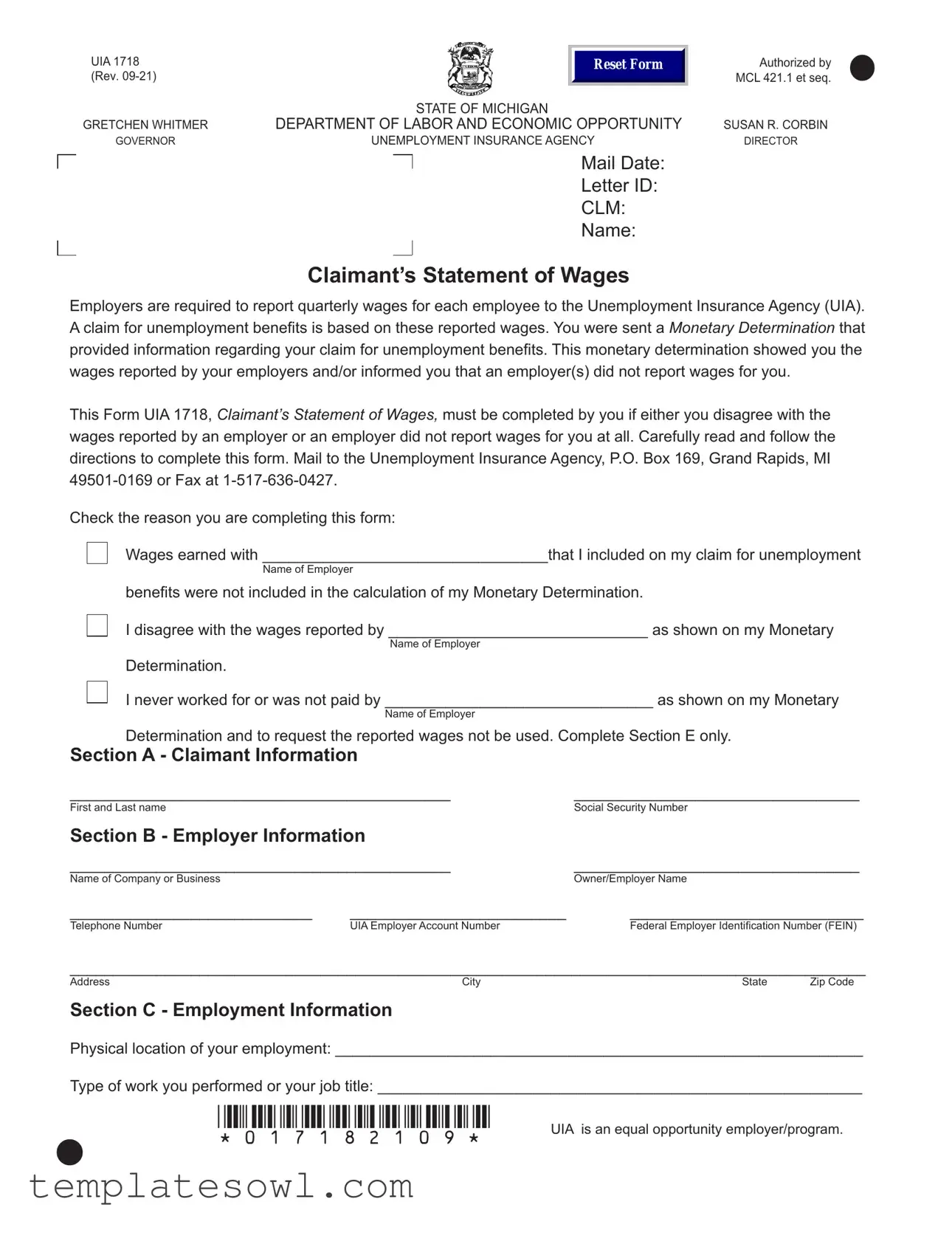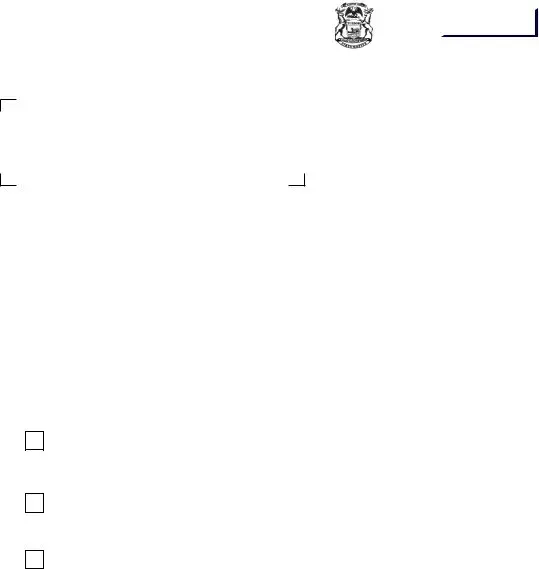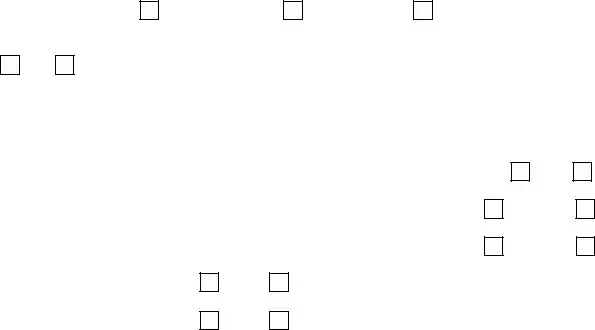UIA 1718 |
|
|
|
Reset Form |
(Rev. 09-21) |
|
|
|
|
|
|
|
STATE OF MICHIGAN |
GRETCHEN WHITMER |
DEPARTMENT OF LABOR AND ECONOMIC OPPORTUNITY |
GOVERNOR |
UNEMPLOYMENT INSURANCE AGENCY |
|
|
|
|
Mail Date: |
|
|
|
|
|
|
|
|
|
|
Letter ID: |
|
|
|
|
CLM: |
|
|
|
|
Name: |
Authorized by |
• |
MCL 421.1 et seq. |
SUSAN R. CORBIN |
DIRECTOR |
|
Claimant’s Statement of Wages
Employers are required to report quarterly wages for each employee to the Unemployment Insurance Agency (UIA). A claim for unemployment benefits is based on these reported wages. You were sent a Monetary Determination that provided information regarding your claim for unemployment benefits. This monetary determination showed you the wages reported by your employers and/or informed you that an employer(s) did not report wages for you.
This Form UIA 1718, Claimant’s Statement of Wages, must be completed by you if either you disagree with the wages reported by an employer or an employer did not report wages for you at all. Carefully read and follow the directions to complete this form. Mail to the Unemployment Insurance Agency, P.O. Box 169, Grand Rapids, MI 49501-0169 or Fax at 1-517-636-0427.
Check the reason you are completing this form:
Wages earned with _________________________________that I included on my claim for unemployment
Name of Employer
benefits were not included in the calculation of my Monetary Determination.
I disagree with the wages reported by ______________________________ as shown on my Monetary
Name of Employer
Determination.
I never worked for or was not paid by _______________________________ as shown on my Monetary
Name of Employer
Determination and to request the reported wages not be used. Complete Section E only.
Section A - Claimant Information
____________________________________________ |
_________________________________ |
First and Last name |
|
Social Security Number |
Section B - Employer Information |
|
____________________________________________ |
_________________________________ |
Name of Company or Business |
|
Owner/Employer Name |
____________________________ |
_________________________ |
___________________________ |
Telephone Number |
UIA Employer Account Number |
Federal Employer Identification Number (FEIN) |
____________________________________________________________________________________________
Address |
City |
State |
Zip Code |
Section C - Employment Information |
|
|
|
Physical location of your employment: _____________________________________________________________
Type of work you performed or your job title: ________________________________________________________ |
• |
*017182109* |
UIA is an equal opportunity employer/program. |
|
UIA 1718 (Rev. 09-21)
How were you paid?
Letter ID:
Other - explain: ____________________
Was there other remuneration (e.g. bonuses, commissions, 401K, room and board, etc.) in your wages?
Were deductions made from your pay (e.g. FICA, income taxes, etc.) in your wages? |
No |
Total gross wages during current calendar year: $____________________ |
actual |
Total gross wages during preceding calendar year: $__________________ |
actual |
Were there other employees? |
No |
Yes - how many? ______________ |
|
Is the employer still operating? |
No |
Yes |
|
Additional comments: |
|
|
|
Section D - Quarterly Wage Information
You must report the quarterly gross wages (before taxes) on the chart on the next page. There are four calendar quarters per year. The quarters are numbered and are the same from year to year. Each quarter contains three calendar months as follows:
1st Quarter |
January 1 |
through |
March 31 |
2nd Quarter |
April 1 |
through |
June 30 |
3rd Quarter |
July 1 |
through |
September 30 |
4th Quarter |
October 1 |
through |
December 31 |
The involved quarters are the same quarters that are shown on your Monetary Determination under the heading “Monetary Determination Calculations”. Label the chart on the next page with the same quarter dates.
•If you are completing this form because wages earned with an employer that you included on your claim were not used in the calculation of your Monetary Determination, complete all quarters that contained wages from that employer.
•If you are completing this form because you disagree with the wages reported by your employer, complete only the quarters that you disagree with.
If your address changes, it is important to update it with the Unemployment Insurance Agency.
If you have questions, you may contact us through your MiWAM account or by calling 1-866-500-0017. For telephone or Local Office hours of operation, visit www.michigan.gov/uia. TTY service is available at 1-866-366-0004.
UIA 1718 |
Letter ID: |
• |
|
(Rev. 09-21) |
|
These quarterly charts allow you to enter wage information per week to help you determine your quarterly total wages. If you know your gross wages for each quarter, complete only the Total Quarterly Wage box for each involved quarter. Wages are reported in the quarter they are paid to you.
Example: You may have worked during the last week of March (1st quarter), but you were not paid until April (2nd quarter). These wages must be reported in the 2nd quarter (the quarter containing the date you were PAID).
You are required to send in clear, legible proof of wages to support the information you provide on this form. This can include check stubs, W-2s, payroll records, or a letter from the employer with payroll information. Proof of wages must be included in the order for the Unemployment Insurance Agency to use the information you are providing.
|
Quarter ___ |
Year ______ |
Quarter ___ |
Year ______ |
Quarter ___ |
Year ______ |
Quarter ___ |
Year ______ |
Quarter ___ |
Year ______ |
|
WEEK PAID |
GROSS WAGES |
WEEK PAID |
GROSS WAGES |
WEEK PAID |
GROSS WAGES |
WEEK PAID |
GROSS WAGES |
WEEK PAID |
GROSS WAGES |
|
PAID |
PAID |
PAID |
PAID |
PAID |
|
|
|
|
|
|
|
|
|
|
|
|
|
|
|
|
|
|
|
|
|
|
|
|
|
|
|
|
|
|
|
|
|
|
|
|
|
|
|
|
|
|
|
|
|
|
|
|
|
|
|
|
|
|
|
|
|
|
|
|
|
|
|
|
|
|
|
|
|
|
|
|
|
|
|
|
|
|
|
|
|
|
|
|
|
|
|
|
|
|
|
|
|
|
|
|
|
|
|
|
|
|
|
|
|
|
|
|
|
|
|
|
|
|
|
|
|
|
|
|
|
|
|
|
|
|
|
|
|
|
|
|
|
|
|
|
|
|
|
|
|
|
|
|
|
|
|
|
|
|
TOTAL |
|
TOTAL |
|
TOTAL |
|
TOTAL |
|
TOTAL |
|
|
Quarterly |
|
Quarterly |
|
Quarterly |
|
Quarterly |
|
Quarterly |
|
|
Wages |
|
Wages |
|
Wages |
|
Wages |
|
Wages |
|
|
|
|
|
|
|
|
|
|
|
|
Section E - Certification Statement
Certification: I certify that the information I have reported is true and correct. I understand that if I intentionally make a false statement, misrepresent facts or conceal material information, I may be required to pay damages and could be subject to criminal prosecution.
_____________________________________________________ |
_______________________ |
Signature |
Date |
• |
*017182109* UIA is an equal opportunity employer/program. |
|


